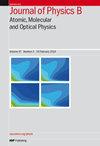Sub-Doppler laser cooling and magnetic trapping of natural-abundance fermionic potassium
IF 1.5
4区 物理与天体物理
Q3 OPTICS
Journal of Physics B: Atomic, Molecular and Optical Physics
Pub Date : 2024-02-09
DOI:10.1088/1361-6455/ad2181
引用次数: 0
Abstract
We demonstrate the largest number of 40K atoms that has ever been cooled to deeply sub-Doppler temperatures in a single-chamber apparatus without using an enriched source of potassium. With gray molasses cooling on the自然丰度费米子钾的亚多普勒激光冷却和磁捕获
我们展示了在不使用富钾源的情况下,在单室仪器中将 40K 原子冷却到深亚多普勒温度的最大数量。在标准 D2 线磁光阱之后的 D1 线上使用灰色糖蜜冷却,我们在 10(2) µK 温度下获得了 3×105 个原子。我们达到的密度足以通过飞行时间法的吸收成像测量温度。我们用磁力捕获了 F=7/2 超精细基态的 mF=-3/2、-5/2 和 -7/2 齐曼态的混合物,共捕获了寿命为 0.6 秒的 5×104 个原子或寿命为 2.8 秒的∼103 个原子,这取决于选择钾分配器的温度是为了使原子数最大化还是使寿命最大化。0.6 秒的本底压力限制寿命是一个合理的起点,可用于在光学镊子中进行原子和/或分子的原理验证实验,以及在传输到二级腔室的情况下与其他物种进行共振冷却。我们的研究结果表明,非富集钾可用于优化含有 40K 的实验装置的初始建造阶段,从而有效延长富集源的使用寿命。此外,对相对少量的钾原子进行亚多普勒冷却和磁捕获的演示可能会影响激光冷却放射性同位素钾的实验。
本文章由计算机程序翻译,如有差异,请以英文原文为准。
求助全文
约1分钟内获得全文
求助全文
来源期刊
CiteScore
3.60
自引率
6.20%
发文量
182
审稿时长
2.8 months
期刊介绍:
Published twice-monthly (24 issues per year), Journal of Physics B: Atomic, Molecular and Optical Physics covers the study of atoms, ions, molecules and clusters, and their structure and interactions with particles, photons or fields. The journal also publishes articles dealing with those aspects of spectroscopy, quantum optics and non-linear optics, laser physics, astrophysics, plasma physics, chemical physics, optical cooling and trapping and other investigations where the objects of study are the elementary atomic, ionic or molecular properties of processes.

 求助内容:
求助内容: 应助结果提醒方式:
应助结果提醒方式:


